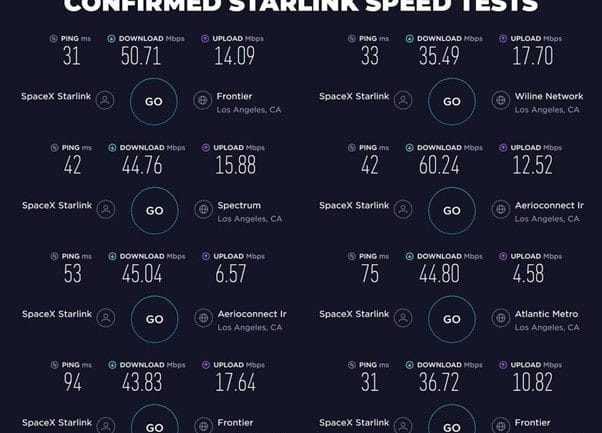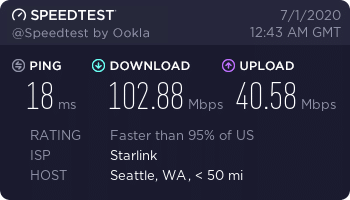SpaceX is deploying a constellation of thousands of mass-produced small satellites in Low Earth Orbit (LEO) called Starlink. The constellation will deliver high-speed, low cost Internet to every mining and exploration project globally.
SpaceX said, “Starlink will deliver high-speed broadband Internet to locations where access has been unreliable, expensive, or unavailable”. The initial goal is to cover Northern Latitudes in 2020, then rapidly expand to global coverage of the populated world by 2021-22. Early indications are it will be priced at 99 USD per month, plus 500 USD for the starter kit – an antenna, tripod and WIFI router.
North American volunteers are already testing it. Reddit contributor Snnackss, complied the velocity tests performed by Beta Testers:

Reddit user Smoke-away, published a list of more velocity tests with a maximum confirmed speed:

Many mining and exploration companies are hampered by low quality communications, resulting in the persistence of costly site-based IT infrastructure. Site based administrative teams are also less efficient and more costly to maintain and delays in sharing of data and information hamper the quality and timeliness of decisions that impact the success of projects.
Fast, cheap Internet across the most remote and distant mining regions of the world will strengthen the ability of centralised management teams in developed regions to leverage their experience to achieve better, more consistent technical decision making, safety, and performance at distant projects.
The wider coverage promised by Starlink will spur more development of Cloud based information and operational support systems, extending the benefits of Cloud and mobile, to the more remote mineral regions of the globe.
According to Gartner, the acceptance of Cloud is not just about lowering costs and greater efficiency. Many companies see it as priming themselves for becoming “early adopters of disruptive innovations that will define the future”. This is as true for mining as any other industry.
Imago was an early innovator in Cloud data management, focusing on geological photography. In just a few years, Imago has been adopted globally by companies ranging from the smallest explorers to the largest miners. Imago delivers geological core and chip photos to geology teams instantly, with high performance viewing made possible by the Cloud. Integration with geology tools such as Leapfrog and acQuire mean that the images are viewed continuously during modelling and interpretation, raising the quality and consistency of the models produced.
The instant visibility of the geological images also means that experienced geologists can monitor the consistency of logging, identifying training requirements for logging teams close to home and in developing regions. Importantly, drilling programs can be adjusted in real time, to optimise plans as live images of the chips and core become available.
According to Federico Arboleda, Imago Founder, Imago is working with multiple customers to implement machine learning using the geological images with the goal of delivering rapid geological insights to improve the speed and quality of logging and interpretation.
The Starlink project will help extend the benefits of Imago to projects in regions where Internet is poor, and travel is ever more challenging. The goals are better management control and increasing quality of drilling and geological decisions at the far reaches of the globe where many of the untapped exploration and mining opportunities are located.
View the guide to linking Leapfrog to Imago: View Guide >>
Please contact Imago support for help linking other geology and mine planning tools to Imago. Imago Support >>




